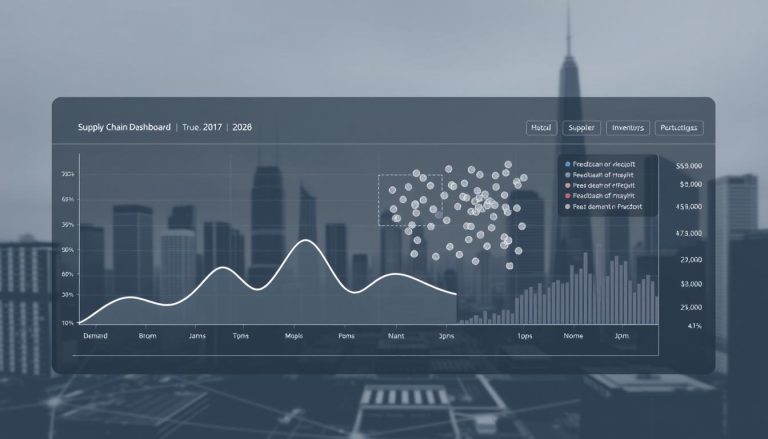Unlock the Power of Supply Chain Strategy
Today, the boardrooms in the United States view supply chain strategy as a fundamental driver of business value. The COVID-19 pandemic, trade tariffs, port blockages, and shipping shortages have prompted a shift. Leaders now focus on a disciplined, end-to-end approach. They aim to align all aspects of the supply chain to cut costs and enhance service reliability.
This article offers a data-driven look at effective supply chain management. It draws from research by McKinsey, Gartner, and the Federal Reserve. It shows how optimized operations can reduce lead times, boost quality, and increase resilience while safeguarding cash flow.
Practical strategies are outlined, including strategic sourcing, demand planning, and network design. The 2024 toolkit also includes AI, machine learning, and predictive maintenance. These tools aim to improve on-time delivery and lower working capital.
The following sections will explore proactive versus reactive risk management, stress testing, near-shoring, and route diversification. The goal is to create a continuous process. This process should enhance profitability and customer satisfaction through effective management and optimization—without losing control or flexibility.
What Is a Modern Supply Chain Strategy and Why It Matters for Competitive Advantage
A modern supply chain strategy is a blueprint for moving goods, data, and cash from raw material to customer. It aligns with finance, procurement, and sales, balancing growth and risk. Companies like Amazon, Apple, and Walmart use analytics to manage sourcing, production, and delivery.
Executives now evaluate supply chain performance alongside financial metrics. This change comes from pandemic lessons, trade policy, and freight volatility. As markets shift, networks, demand profiles, and supplier portfolios adjust.
End-to-end definition: from sourcing to last-mile delivery
Scope spans from supplier qualification to last-mile delivery, including returns and after-sales service. Supply chain optimization links all stages with AI, IoT, and analytics. This creates a unified plan.
Coordinated execution needs shared data with manufacturers and retailers. Robust master data and clear policies enable synchronized flows and faster market entry.
Primary objectives: cost, lead time, quality, and service reliability
Goals include total landed cost, compressed lead time, stable quality, and dependable delivery. Teams track metrics like order accuracy and on-time delivery. These guide continuous planning and improvement.
Standard practices include right-sizing safety stock and lean material flow. Vendor scorecards and digital quality checks help manage costs while protecting service.
How effective supply chain management fuels profitability and customer satisfaction
Well-run networks reduce waste and free up working capital. Accurate demand signals and disciplined replenishment cut stockouts. This raises fill rates and repeat purchases.
Organizations reassess footprints as demand shifts. Nearshoring, regional DCs, and modal mix ensure resilience and speed. Continuous review of metrics keeps the plan competitive as costs and lead times change.
| KPI | Definition | Business Impact | Typical Improvement Lever |
|---|---|---|---|
| On-Time Delivery | Orders delivered by promised date | Higher customer retention and revenue | Carrier optimization and accurate ATP in supply chain planning |
| Inventory Turnover | COGS divided by average inventory | Lower holding cost and better cash flow | Demand shaping and multi-echelon supply chain optimization |
| Perfect Order Rate | Orders that are complete, accurate, undamaged, and on time | Fewer returns and service credits | WMS quality checks and standardized pack-out |
| End-to-End Lead Time | Time from order capture to delivery | Faster cycle times and market responsiveness | Network redesign and synchronized production planning |
| Forecast Accuracy | Statistical accuracy at SKU or family level | Reduced stockouts and excess | Machine learning models within supply chain planning |
Key Features of High-Performance Supply Chains
High-performance networks turn volatility into advantage through disciplined design and execution. Leaders align their logistics strategy with revenue goals, cash discipline, and risk posture. They embed supply chain optimization into planning cycles, workforce routines, and partner governance.
Flexibility and agility to adapt to volatile demand
Agility is built on modular plants, adaptive distribution, and balanced inventory. Companies like Procter & Gamble use postponement to switch late in the cycle and protect service. Teams adjust the just-in-time versus just-in-case mix based on channel, season, and margin.
Playbooks include dynamic safety stock, multi-sourcing, and cross-docking. Scenario drills compress response time during strikes, weather events, or supplier capacity shocks.
End-to-end visibility and collaborative data sharing
End-to-end views connect suppliers, in-transit assets, facilities, and last mile. Real-time mapping and control towers flag exceptions and trigger alerts. With shared milestones, partners execute faster and reduce manual checks.
Companies such as Maersk and UPS provide live status feeds that support collaborative planning. This leads to shorter decision cycles and fewer expedites within optimized supply chain operations.
Technology integration: AI, automation, and real-time analytics
AI improves demand sensing and forecasting while optimizers refine network design and routing. Robotic process automation clears repetitive tasks; autonomous mobile robots speed picking. Predictive maintenance cuts downtime on lines and fleets.
Hyper-automation unifies AI, machine learning, RPA, and iBPM to coordinate cross-functional work. These stacks raise forecast accuracy, reduce touches, and enhance logistics strategy across regions.
Sustainability embedded across optimized supply chain operations
Carbon-aware routing, lightweight packaging, and modal shifts reduce emissions. Brands like IKEA and Tesla invest in renewable power and recyclable materials to lower intensity and improve resilience.
Traceability systems verify sourcing claims and waste-reduction targets. Embedding sustainability within supply chain optimization also cuts fuel spend and improves asset utilization.
Types of Strategies Shaping Today’s Supply Chains
Market leaders align product flow, data, and capital with clear rules for effective supply chain management. The mix spans customer focus, predictive analytics, shared visibility, and smart automation. Strong supply chain planning and a precise logistics strategy turn these pillars into measurable gains.
Customer-centric models and mass customization
Firms like Nike and Dell use modular design, late-stage assembly, and direct-to-consumer channels to speed response. This approach links demand signals to production slots and flexible distribution. The result is tighter service windows and lower cost-to-serve within effective supply chain management.
Predictive business: demand forecasting and sensing
Retailers and CPG brands deploy machine learning to fuse POS data, promotions, weather, and events. Predictive maintenance and risk analytics stabilize capacity and transport assets. When embedded in supply chain planning, these models lift forecast accuracy and reduce stockouts.
Visibility-driven networks and collaborative planning
Real-time tracking, EDI, and shared control towers connect suppliers, 3PLs, and carriers. Joint scenario modeling aligns replenishment and allocation decisions. This transparency supports a resilient logistics strategy and improves fill rates and lead-time reliability.
Smart automation in warehousing, transport, and decisioning
Robotics, AS/RS, and autonomous mobile robots enhance pick speed and safety. Autonomous yard moves and dynamic routing compress cycle times. AI decision engines optimize inventory and replenishment, anchoring effective supply chain management with consistent execution.
| Strategy Type | Primary Capabilities | Operational Impact | Business Metric Uplift | Planning and Logistics Notes |
|---|---|---|---|---|
| Customer-Centric & Mass Customization | Modular SKUs, late differentiation, DTC fulfillment | Faster response to demand shifts | +3–6 pts service level; -10–15% returns | Align supply chain planning with segmented service policies and a flexible logistics strategy |
| Predictive Forecasting & Sensing | ML models, event signals, predictive maintenance | Stabilized production and transport capacity | +8–12% forecast accuracy; -12–18% stockouts | Integrate demand sensing into S&OP and carrier scheduling for effective supply chain management |
| Visibility-Driven Collaboration | Control towers, network mapping, shared KPIs | Coordinated replenishment and allocation | -15–20% lead-time variance; +5–8 pts OTIF | Use common data layers to synchronize supply chain planning and a unified logistics strategy |
| Smart Automation | Robotics, AS/RS, autonomous transport, AI decisioning | Higher throughput with consistent quality | +20–30% picking productivity; -25–35% errors | Embed automation rules into WMS/TMS for effective supply chain management and stable planning cycles |
Supply Chain Strategy
A supply chain strategy aligns end-to-end capabilities with corporate goals. These goals include cost leadership, service differentiation, and market expansion. It begins by defining targets and setting measurable supply chain performance metrics. Metrics like order accuracy, on-time delivery, lead time, and inventory turns guide financial decisions.
These decisions involve technology adoption, facility placement, and inventory policies. They support supply chain optimization across the network.
Development integrates five capabilities. These are supply sense, supply response, deciding and committing, demand sense, and demand response. The strategy evaluates demand types and product traits. It considers customer location patterns and supplier geography.
Implementation relies on S&OP to synchronize sales, production, and distribution. It links plans to supply chain performance metrics. Network design models optimize facility locations, transportation modes, and flow paths.
Continuous improvement routines adjust reorder rules, safety stock, and planning horizons. This sustains supply chain optimization and reduces volatility in execution.
Scenario planning and periodic stress tests assess exposure to geopolitical shifts, port congestion, and technology changes. Teams simulate capacity constraints, lead-time shocks, and demand spikes. This supports governance, funding choices, and change management across procurement, manufacturing, logistics, and customer operations.
- KPIs and trade-offs: Balance service levels with cost-to-serve using supply chain performance metrics that link to margin.
- Design choices: Select make-versus-buy, plant footprints, and cross-dock use to drive supply chain optimization.
- Policy tuning: Align order promising, allocation rules, and inventory segmentation with demand patterns.
- Technology enablement: Apply APS, WMS, TMS, and real-time data to support the supply chain strategy at scale.
Strategic Sourcing and Supplier Relationship Management
Strategic sourcing focuses on cost, service, and sustainability. It involves comparing total landed cost, service reliability, and ESG data. This approach is key to effective supply chain management and optimized operations.
Balancing price, quality, delivery, and supplier sustainability
Procurement weighs price against quality, defect rates, and on-time delivery. Audits check for ISO certifications and review carbon and water metrics. Benchmarking with APQC and ISM sets targets for strategic sourcing.
Leaders monitor total cost of ownership, including logistics and warranty risk. Scorecards prioritize quality and delivery over cost. This ensures product integrity without compromising on savings.
Supplier risk profiling, diversification, and near-shoring
Risk models assess financial health and geographic exposure. Teams map supply chain nodes to identify chokepoints. Diversification and near-shoring reduce lead times and variability.
Companies like Toyota and Procter & Gamble use tier-mapping and buffer strategies. These strategies improve response to demand swings and maintain supply chain stability.
Win-win agreements that stabilize cash flow and service levels
Buyer-led supply chain finance pays invoices early based on the buyer’s credit. This shortens the supplier’s cash cycle. When SCF is unavailable, receivables finance provides liquidity through invoice sales.
Balanced terms include volume commitments and service-level KPIs. Joint improvement projects and audits elevate supplier priority. These measures strengthen strategic sourcing and maintain supply chain stability.
Planning Foundations: Demand Planning, S&OP, and Network Design
Effective supply chain planning connects market signals to operational choices. It benefits from supply chain optimization and uses precise performance metrics. This approach reduces uncertainty and aligns resources across the enterprise.

Demand planning with statistical and machine learning methods
Accurate forecasts combine traditional statistics with machine learning. Teams use ARIMA or exponential smoothing alongside gradient boosting and recurrent neural networks. This blend captures trends, seasonality, and promotional effects.
Inputs from real-time data, such as point-of-sale, weather, and social media, enhance demand sensing. This leads to more stable production schedules, inventory levels, and transportation capacity.
This method improves supply chain planning by reducing bias and error. It supports optimization across procurement and logistics.
Sales and Operations Planning to align supply with business goals
S&OP aligns the demand plan with supply capabilities and financial plans. Leaders from sales, marketing, operations, and finance engage in monthly scenario modeling. They aim to balance service, cost, and inventory levels.
What-if analyses test various scenarios, including price changes and capacity shifts. The outcome is a unified plan that determines build schedules, procurement volumes, and financial commitments.
Organizations track performance metrics like on-time delivery and cost-to-serve. These metrics validate plan quality and prompt adjustments during volatile periods.
Supply chain network design for optimal facility and flow decisions
Network design evaluates facility locations, throughput, transport modes, and flow paths. It uses mixed-integer optimization and discrete-event simulation. Models consider service-level targets, cost curves, and demand geography.
Regular redesigns support new channels, enhance responsiveness, and unlock savings. Companies assess cross-dock use, port choices, and near-shore options to reduce lead time risks.
Integrating network analytics into planning mitigates bottlenecks and boosts asset utilization. It strengthens supply chain optimization over time.
| Planning Layer | Primary Objective | Typical Methods | Key Inputs | Supply Chain Performance Metrics | Business Impact |
|---|---|---|---|---|---|
| Demand Planning | Improve forecast accuracy | ARIMA, exponential smoothing, gradient boosting, RNN/LSTM | POS data, orders, promotions, weather, price, seasonality | MAPE, bias, inventory turns | Stabilized schedules, lower expedites, tighter inventory targets |
| S&OP | Align supply and finance to market demand | Scenario modeling, constraint analysis, capacity balancing | Forecast, capacity, lead times, COGS, margin goals | On-time in-full, cost-to-serve, order-to-delivery cycle time | Unified plan, improved service, controlled working capital |
| Network Design | Optimize facility footprint and flows | Mixed-integer programming, simulation, sensitivity analysis | Demand geography, transport rates, labor costs, service targets | Total landed cost, response time, utilization | Reduced structural cost, faster delivery, resilient capacity |
Inventory Management Strategy and Optimization Levers
A disciplined inventory management strategy connects service goals with working capital and risk management. It harmonizes with demand planning, S&OP, and network design to ensure stock is strategically placed. This approach boosts inventory turns, enhances fill rates, and minimizes write-downs, contributing to supply chain optimization.
From just-in-time to just-in-case: balancing service and capital
Companies adopt policies that span a spectrum. Just-in-time reduces holding costs and conserves cash but relies on consistent lead times. In contrast, just-in-case builds buffers to handle unexpected disruptions like port delays or semiconductor shortages. Scenario models help size these buffers, balancing cash preservation with service level protection within an inventory strategy that supports optimized supply chain operations.
Safety stock tuning, ABC analysis, and cycle counting
Safety stock levels are adjusted based on demand variability and supplier lead times. This is done using service-level targets and probabilistic methods. ABC analysis focuses on high-value or high-velocity items (A-items), with lighter rules for B and C items. Cycle counting maintains inventory accuracy without halting operations, with A-items counted more frequently to prevent stockouts and support supply chain optimization.
Vendor-managed inventory and consignment programs
Vendor-managed inventory delegates replenishment to suppliers, with clear performance metrics for fill rate and availability. Consignment programs transfer ownership until use, reducing capital requirements and smoothing cash flow. When combined with multi-echelon optimization and shared data from platforms like SAP Integrated Business Planning or Oracle Cloud SCM, these strategies enhance availability and reduce dwell time, optimizing supply chain operations.
- Key outcomes: higher inventory turns, reduced storage costs, improved order fill, and lower capital exposure within a cohesive inventory management strategy.
- Enablers: demand sensing, reliable lead-time data, and governance that ties parameters to S&OP for end-to-end supply chain optimization.
Building Resilience and Managing Risk Across the Chain
Resilience begins with a detailed map of the network and a thorough risk register. Teams employ supplier audits, multi-tier visibility, and scenario modeling to test the supply chain against shocks. This includes pandemics, tariffs, and port closures. By diversifying suppliers and transport modes, near-shoring, and planning for contingencies, companies can reduce risk and enhance supply chain management.
Stress testing helps set buffers and alternate routes. Companies assess time-to-recover, time-to-survive, and service impact across nodes. These metrics guide inventory placement, modal mix, and plant flexibility, ensuring each decision aligns with the logistics strategy.
When disruption occurs, a swift response is critical. Emergency sourcing, expedited freight, temporary capacity shifts, and crisis communication help stabilize operations. Yet, these measures increase costs. Flexible labor scheduling, rapid quality checks, and well-documented insurance claims aid in restoring flow while protecting profit margins.
Key resilience elements include end-to-end visibility systems, agile manufacturing and distribution, and redundancy across facilities and key partners. Risk transfer through insurance and shared-risk agreements helps manage volatility. Collaboration with strategic suppliers and 3PLs enables synchronized responses and faster recovery, all aligned with the supply chain strategy.
Continuous improvement is essential. Post-incident reviews, simulations, and playbook updates embed lessons learned. Standardized drills and best-practice adoption strengthen governance, keeping supply chain management aligned with evolving demand and geopolitical risks within a disciplined logistics strategy.
- Proactive controls: mapping, risk assessment, diversification, near-shoring, resilient infrastructure, digital visibility.
- Reactive controls: emergency sourcing, expedited freight, capacity shifts, crisis communication, flexible labor, insurance claims.
- Levers: visibility platforms, agile plants and DCs, redundancy, risk transfer, and collaborative partnerships with leading 3PLs.
| Resilience Element | Business Objective | Key Metric | Example Practice |
|---|---|---|---|
| Supply Chain Mapping | Reduce blind spots | Tier-2/3 coverage (%) | Multi-tier BOM and site geocoding |
| Scenario Modeling | Quantify exposure | Value at Risk ($) by node | Tariff and route-closure simulations |
| Diversification | Cut concentration risk | Herfindahl index by supplier | Dual sourcing and multi-modal routing |
| Buffers and Redundancy | Protect service levels | Time-to-survive vs. time-to-recover | Strategic safety stock and backup DCs |
| Response Playbooks | Accelerate recovery | Mean time to respond (hours) | Pre-approved carriers and alt SKUs |
| Risk Transfer | Stabilize cash flow | Insured loss coverage (%) | Parametric insurance and shared-risk terms |
Conclusion
A modern supply chain strategy is a data-driven, end-to-end model. It connects sourcing, production, logistics, inventory, and customer service to financial outcomes. Leaders who align priorities with business goals and embed S&OP create a control system. This system translates demand signals into reliable supply decisions.
This approach elevates effective supply chain management. It supports optimization across planning, execution, and service. Organizations that invest in demand planning, network design, and inventory optimization achieve lower costs and shorter lead times. They also see higher fill rates.
Strategic sourcing and supplier relationship management stabilize cash flow. They safeguard capacity during peak periods. These efforts convert variability into predictable performance, protecting margins in the United States market.
AI, machine learning, and hyper-automation improve forecast accuracy and automate workflows. They optimize networks and enable predictive maintenance. Visibility platforms enhance risk control and compliance, while sustainability practices reduce waste.
Together, these tools make effective supply chain management measurable, scalable, and resilient. Resilience grows with diversification, stress testing, and balanced just-in-time and just-in-case policies. Treating supply chain strategy as a continuous, KPI-driven process ensures sustained optimization.
This approach leads to superior customer satisfaction and durable competitive advantage.
FAQ
How does a modern supply chain strategy create competitive advantage?
A modern supply chain strategy integrates sourcing, manufacturing, logistics, inventory, and customer service. It aims to lower costs and compress lead times while improving quality and delivery times. By focusing on key performance metrics, companies enhance service reliability and margins.
Studies post-COVID-19 have elevated supply chain management to the C-suite level. It now directly impacts pricing, resilience, and growth. This shift highlights the importance of a well-managed supply chain in today’s business landscape.
What are the core components of effective supply chain management today?
Effective supply chain management includes demand planning, S&OP, network design, strategic sourcing, and inventory optimization. High-performing firms also leverage visibility platforms, predictive maintenance, and automation. These tools help orchestrate workflows and optimize operations.
They balance service levels, working capital, and total landed cost across the network. This approach ensures efficient supply chain operations.
How do AI and machine learning improve supply chain planning and optimization?
AI and machine learning enhance demand sensing and forecast accuracy. They optimize inventory and routing decisions. These technologies power predictive maintenance and real-time analytics.
They enable faster decision-making, lower working capital, and higher on-time delivery rates. This framework supports robust supply chain planning.
What is the difference between proactive and reactive risk strategies?
Proactive strategies focus on prevention, including supply chain mapping and supplier audits. They also involve diversification, near-shoring, stress testing, and scenario modeling. These measures cost less over time and build resilience.
Reactive strategies address disruptions after they occur. They include emergency sourcing, expedited freight, and crisis communication. While proactive measures are cost-effective in the long run, reactive measures ensure short-term continuity.
How should companies balance just-in-time and just-in-case inventory?
Companies balance just-in-time and just-in-case inventory based on service targets, demand variability, and lead-time risk. They adjust safety stock to account for forecast error and supply uncertainty. ABC analysis prioritizes controls on high-value items.
They use cycle counting to maintain accurate records. Multi-echelon inventory optimization and vendor-managed inventory can reduce costs while maintaining fill rates.
What role does strategic sourcing play in supply chain optimization?
Strategic sourcing evaluates total landed cost, service reliability, and ESG criteria to select suppliers. It involves relationship management and collaborative programs. Supply chain finance and receivables financing improve cash flow and stabilize capacity.
These measures safeguard service levels during volatility. They are essential for optimizing the supply chain.
How do visibility platforms and collaborative data sharing improve logistics strategy?
Visibility platforms track materials, work-in-process, and shipments in real time. Shared data enables collaborative planning with suppliers and 3PLs. This supports dynamic routing and capacity balancing.
Transparency raises on-time delivery and reduces expedites. It strengthens logistics strategy across modes and nodes.







